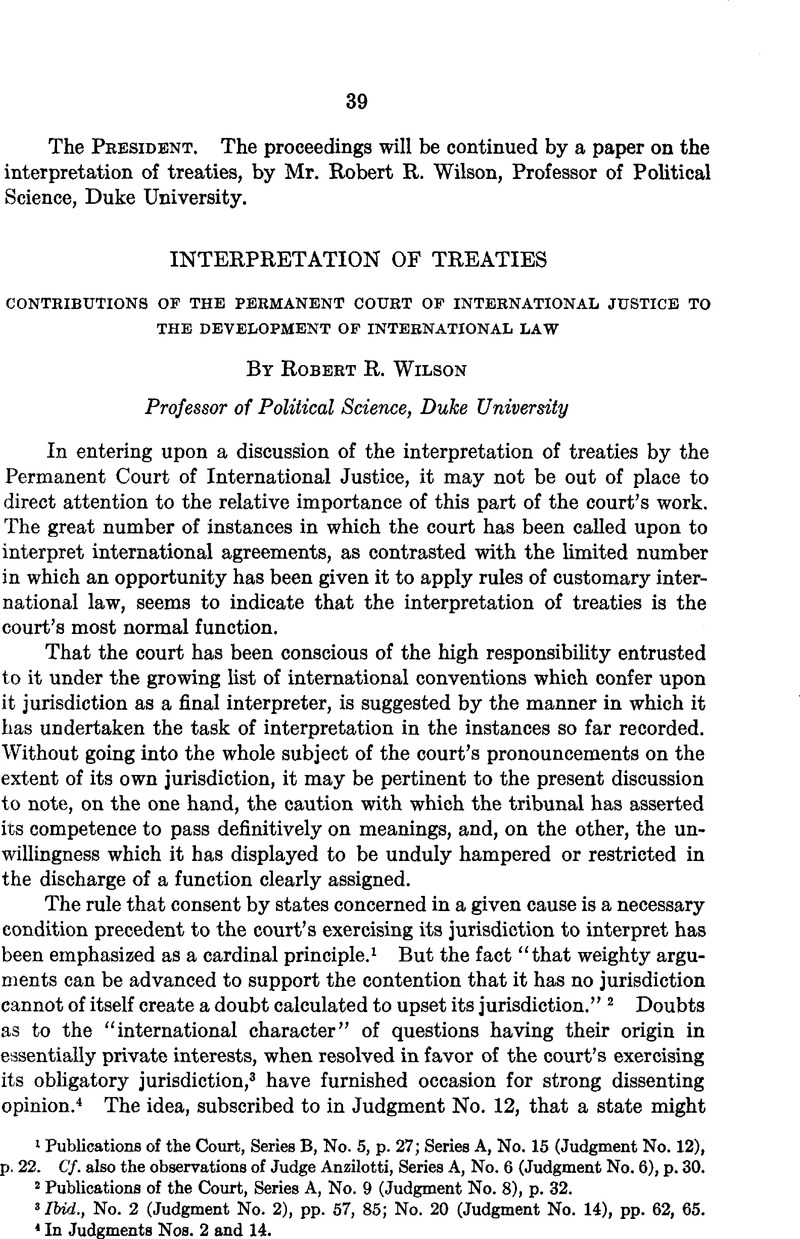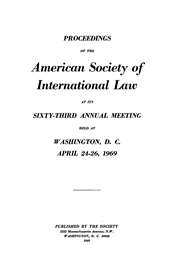No CrossRef data available.
Article contents
Interpretation of Treaties
Published online by Cambridge University Press: 27 February 2017
Abstract

- Type
- Second Session
- Information
- Copyright
- Copyright © American Society of International Law 1930
References
1 Publications of the Court, Series B, No. 5, p. 27; Series A, No. 15 (Judgment No. 12), p. 22. Cf. also the observations of Judge Anzilotti, Series A, No. 6 (Judgment No. 6), p. 30.
2 Publications of the Court, Series A, No. 9 (Judgment No. 8), p. 32.
3 Ibid., No. 2 (Judgment No. 2), pp. 57, 85; No. 20 (Judgment No. 14), pp. 62, 65. 4 In Judgments Nos. 2 and 14.
4 In Judgments Nos. 2 and 14.
5 Publications of the Court, Series A, No. 15, pp. 24, 26; dissenting opinions at pp. 51, 52, 56, 68.
6 Ibid., No. 9 (Judgment No. 8), p. 25; Series A, Nc. 17 (Judgment No. 13), p. 45.
7 Ibid., No. 9, p. 30.
8 Ibid., No. 6 (Judgment No. 6), p. 18. The quotation refers to agreements other than the one which was being interpreted.
9 Ibid., No. 9 (Judgment No. 8), p. 25.
10 Ibid., No. 22, p. 15.
11 Ibid., No. 13, pp. 15, 16.
12 Publications of the Court, Series A, No. 3 (Judgment No. 3); No. 7 (Judgment No.7), pp. 18-19: “There seems to be no reason why States should not be able to ask the Court to give an abstract interpretation of a treaty; rather would it appear that this is one of the most important functions which it can fulfill.”
13 Ibid., No. 13 (Judgment No. 11) p. 20.
14 Ibid., No. 2 (Judgment No. 2), p. 34; No. 13 (Judgment No. 11), p. 16; No. 15 (Judgment No. 12), p. 23.
15 Ibid., No. 1 (Judgment No. 1), pp. 22, 24, 25; against the declared “plain” meaning were offered powerful dissenting opinions based on fundamental principles. Tor other cases where “clear” or “natural” meanings were invoked, see Series B, No. 10, pp. 19, 20; Series B, No. 11, pp. 38, 39; Series B, No. 14, p. 28; dissenting opinion of Judge Moore in the Lotus Case (Series A, No. 10, p. 67), and dissenting opinion of M. Dreyfus, judge ad hoc in the case between France and Switzerland (Series A, No. 22, p. 41).
16 Ibid., Series B, No. 7, p. 20.
17 Ibid., Series A, No. 2, p. 19.
18 Ibid., Series A, No. 7 (Judgment No. 7), p. 41.
19 Publications of the Court, Series A, No. 9 (Judgment No. 8), p. 22.
20 Ibid., Series B, No. 13, p. 19.
21 This question is to be kept distinct from that dealt with in the order of Aug. 20,1929 (Series A, No. 23, Annex 3 to Judgment No. 16) as to evidence in the form of preparatory work inadmissible in respect of certain parties in the case.
22 Publications of the Court, Series B, No. 2, p. 41; Series B, No. 10, p. 16; Series B, No. 12, p. 22; Series B, No. 14, pp. 28, 31; Series A, No. 10 (Judgment No. 9), p. 16.
23 Ibid., Series B, No. 12, p.23.
24 Ibid., Series B, No. 13, p. 18; No. 6, p. 25.
25 Ibid., No. 16, p. 19; Series A, No. 17 (Judgment No. 13), p. 47. Cf. Series B, No. 8, p. 40: “Since the object of this clause is one of equity, it must not be construed in too rigid a manner.”
26 Ibid., Series B, No. 7, p. 17.
27 Ibid., Series A, No. 9 (Judgment No. 8), p. 22. Cf. Judge Huber's dissenting opinion in Series A, No. 15 (Judgment No. 12), p. 52.
28 28 Ibid., Series B, No. 4, p. 24; Series B, No. 13, p. 18; Series A, No. 7 (Judgment No. 7),p. 21; Series A, No. 15 (Judgment No. 12), p. 39.
29 Ibid., Series B, No. 2, p. 23.
30 Publications of the Court, Series A, No. 15 (Judgment No. 12), p. 31.
31 Ibid., No. 5 (Judgment No. 5), pp. 48, 49; Series A, No. 11 (Judgment No. 10), p. 16.
32 Ibid., No. 7 (Judgment No. 7), p. 48.
33 Ibid., No. 23, p. 20.
34 Ibid., No. 23 (Judgment No. 16), p. 26; Series B, No. 11, p. 39.
35 Ibid., No. 23 (Judgment No. 16), p. 26.
36 Ibid., No. 1, p. 25; Series B, No. 14, p. 36.
37 Publications of the Court, Series B, No. 12, p. 26; Series B, No. 16, p. 23.
38 Ibid., Series A, No. 6, p. 14.
39 Ibid., No. 13, pp. 10, 11.
40 Ibid., No. 2, pp. 13,15. The court seemed to give chief consideration to the views of the states concerned on this point. As one of the dissenting judges pointed out, there was only one exchange of views between the Foreign Office and the Greek Legation in London after the intervention of the Greek Government (Ibid., p. 85).
41 Ibid., Series B, No. 4, pp. 23, 24.
42 Cf. the remarks of M. Politis, representing the Polish Government, in Publications of the Court, Series C, No. 13-1, pp. 37-43.
43 Publications of the Court, Series A, No. 9, p. 22
44 Publications of the Court, further statement in Series A, No. 17 (Judgment No.13),p. 29.
45 Series B, No. 12, pp. 27-29. Cf. remarks of M. Novacovitch, with reference to the Court's exercise of arbitral functions, in a dissenting opinion, Series A, No. 20 (Judgment No. 14) p. 80.
46 Professor Charles Cheney Hyde, “The Interpretation of Treaties by the Permanent Court of International Justice,” 24 American Journal of International Law, p. 19.
47 Cf. the suggestion in Judgment No. 16 (Series A, No. 23, p. 27) of a “community of interest” as “the basis of a common legal right.”
48 Publications of the Court, Series B, No. 14, p. 83.
49 Cf. Lord Finlay's remarks in a dissenting opinion (Series A, No. 17, p. 72).
50 See the statement along this line in Advisory Opinion No. 13 (Series B, No. 13, p. 23).


